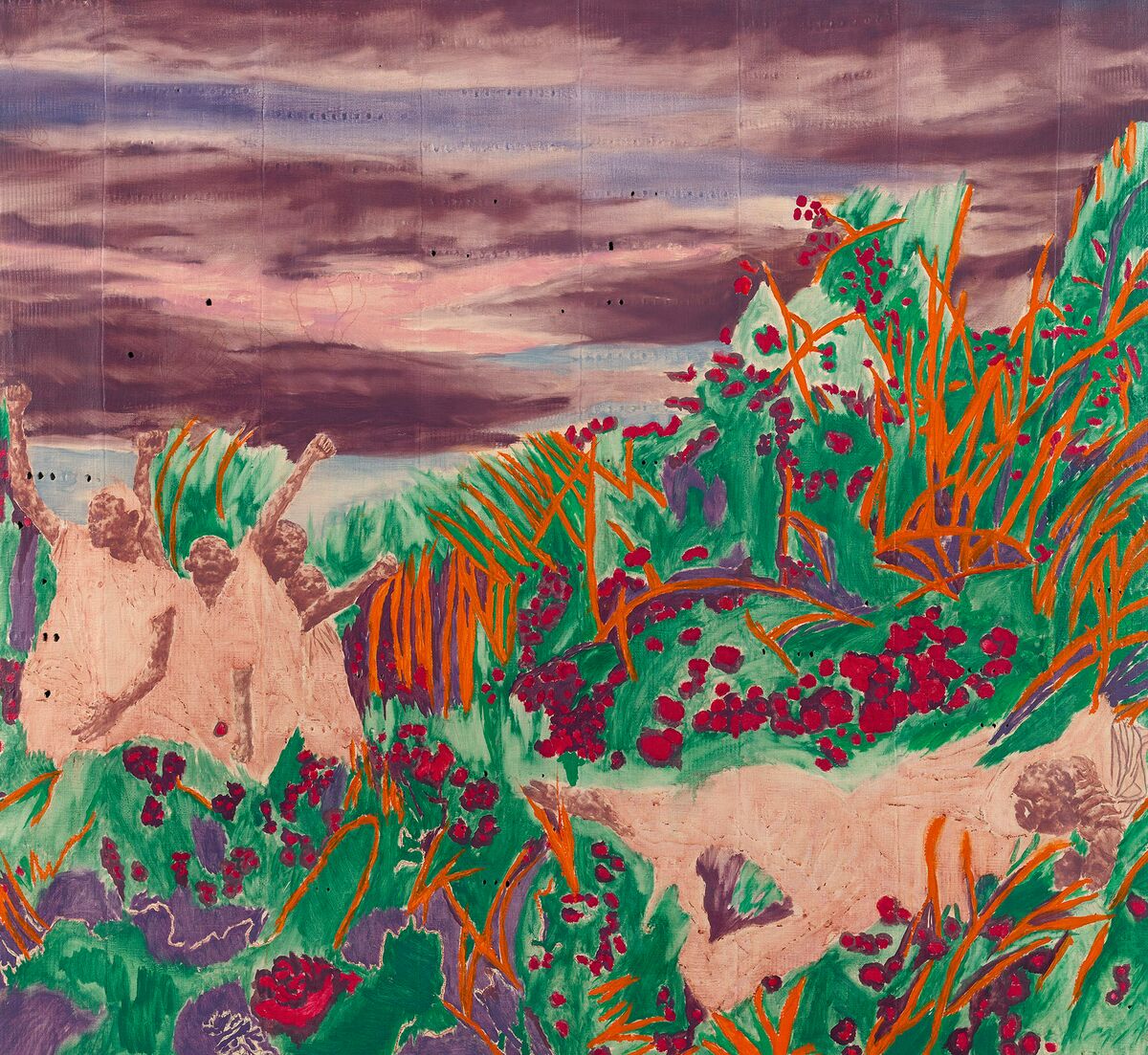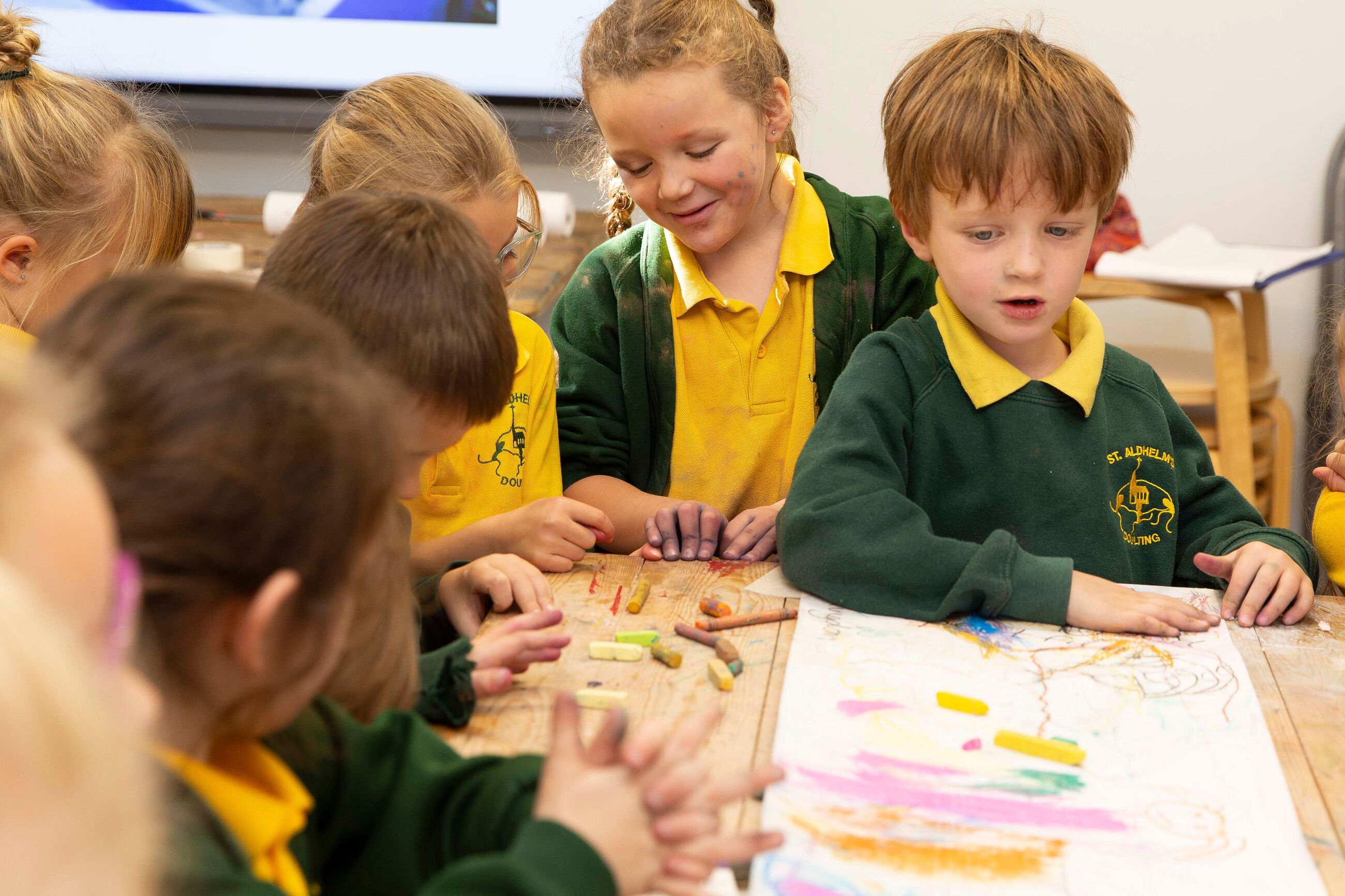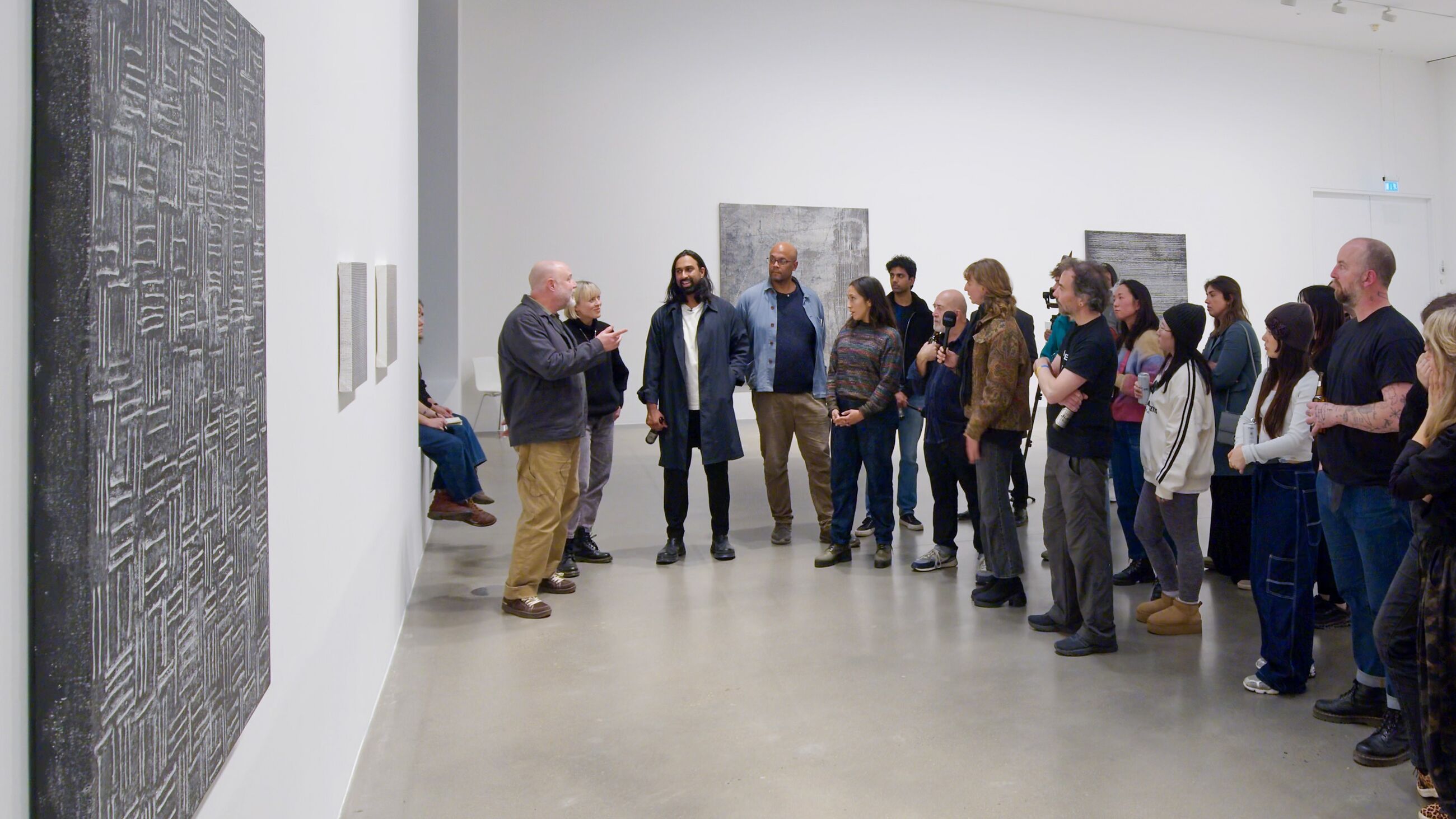Exhibition Learning Notes: ‘Phyllida Barlow. unscripted’

Phyllida Barlow in her studio, 2018 © Phyllida Barlow Estate. Courtesy the Phyllida Barlow Estate and Hauser & Wirth. Photo: Cat Garcia
Exhibition Learning Notes: ‘Phyllida Barlow. unscripted’
This resource has been produced to accompany the exhibition ‘Phyllida Barlow. unscripted,’ curated by Frances Morris, at Hauser & Wirth Somerset from Saturday 25 May 2024 – Sunday 5 January 2025.
Click here to download a PDF version of this resource.
About Phyllida Barlow
With an extensive career that spanned six decades, British artist Phyllida Barlow (1944 –
2023) is celebrated for pushing the boundaries of contemporary sculpture, leaving
a profound impact on the art world and inspiring generations of artists to come.
Born in 1944 in Newcastle upon Tyne, UK, Barlow studied at Chelsea School of Art (1960 –
1963) and graduated from the Slade School of Fine Art in 1966, where she later became a
professor of Fine Art. She became a Royal Academician in 2011, and in 2015 she was awarded
a CBE for her services to the arts in Queen Elizabeth II’s New Year Honours. Barlow’s work has
been exhibited across institutions nationally and internationally. She was commissioned to
create the site-specific exhibition ‘dock’ for the Duveen Galleries of Tate Britain, London, UK in
2014, and in 2017 she represented Britain at the Venice Biennale, Italy.
Barlow had an important influence on younger generations of artists through her work and long
teaching career in London art schools. Her students included Rachel Whiteread, Ángela de la
Cruz and Tacita Dean.
What does the exhibition look like?
In the exhibition, ‘unscripted,’ Barlow’s work takes over Hauser & Wirth Somerset, marking the
10th anniversary of the gallery that was inaugurated by the artist’s solo exhibition ‘GIG’ in 2014.
Beginning in the farmyard, a selection of outdoor sculptures disrupts the gallery’s exterior architectural spaces. Works such as ‘PRANK: jinx’ (2022 – 2023) and ‘untitled: megaphone’ (2014) tower over visitors on arrival. ‘untitled: stackedchairs’ (2014) overflow from the gallery’s granary building, parodying its original purpose for storing items such as grain.
In the Bourgeois Gallery, a selection of standalone sculptural objects occupy the space. ‘Shedmesh’ (1975 – 2020) is a remake of a 1975 work of the same name, constructed from canvases knotted and tied on a grid resembling painting stretchers. ‘Object for the television’ (1994), a rare work from the 1990s, demonstrates how Barlow plays with the familiar household object of a television set and aerial, making it comical and absurd.
Examples of how Barlow’s work pushed the boundaries of scale, materiality and architecture to its limits are on view in the Rhoades Gallery with works such as ‘untitled’ (2007), part of her ‘signs’ series. The textured columns and arches of ‘untitled: 21 arches’ (2012) are mostly made out of polystyrene, taking the place of solid concrete and encourages the visitor to walk around the full perimeter of the sculpture.
A collection of Barlow’s smaller paintings, maquettes and wall works are on display in the Pigsty Gallery. These small paintings, her first experiments on canvas, were produced with larger canvases in mind, some specifically intended to show in this exhibition. The recent wall works in this space were made during the national lockdown, many of these works have not been shown publicly before.
The Workshop Gallery presents a showcase of different iterations of Barlow’s ‘double act’ series (2010 – 2023). Shown through large-scale sculpture made from plaster, cement, plywood and scrim, as well as maquettes and drawings, these works placed together offer insight into how Barlow developed her sculptural language as one of process-based experimentation.
A selection of Barlow’s expressive drawings are on view in the Engine Room. Drawing was always important to the artist and rarely viewed as simply preparation for her sculpture, but rather as an art form in their own right.
The Oudolf Field contains outdoor works displayed amongst the garden’s landscaping. Alluding to Barlow’s earlier ‘Object for....’ series, Barlow’s anthropomorphic rabbit ears reappear as a motif in her series titled ‘PRANK (2022 – 2023) and reference objects found in the home and studio.

Phyllida Barlow, untitled: folly; awnings; 2016/2017 (detail), 2016 – 2017, ‘Phyllida Barlow. folly,’ British Pavilion, 57th Venice Biennale, Italy, 2017 © Phyllida Barlow Estate / British Council. Photo: Ruth Clark
What are the major themes within Barlow’s work?
What is sculpture?
Barlow challenges conventional understandings of sculpture by embracing unconventional
materials, scale and spatial relationships. Her work poses questions about what constitutes
three-dimensional artwork in public spaces and what relationship it can have with its
surroundings. Many of her works appear as vertical masses, draped fabrics and balanced forms
that dominate gallery spaces. These are so large that a team of studio assistants are usually
required to assist in their construction. Through her innovative approach to making, Barlow
redefines this art form as dynamic and experiential.
Materiality
Rejecting the traditional emphasis on permanence and monumentality, Barlow experimented
with humble and ephemeral materials like cardboard, plywood, fabric, wooden pallets and
plaster to make her works. In pushing beyond given material boundaries, Barlow transformed
these everyday materials into dynamic and large-scale sculptures and installations. Barlow’s
choice of materials emphasizes their inherent qualities of tactility and precarity, challenging
notions of fixedness often associated with traditional sculptural materials. Her works refuse to
be just objects, demonstrating that creative expression can emerge from the most unexpected of
material sources.
Space
Barlow engages with space in innovative ways. Her installations are often sprawled across
gallery spaces, blurring the distinction between sculpture and architecture, inviting viewers to
navigate immersive environments. Her works are expansive; they spill out from the architecture
that contains them, reaching into spaces overhead and underfoot. Barlow’s restless invented
forms stretch the limits of mass, volume and height as they block, straddle and balance
precariously. She described her work’s relationship with the space it inhabits as ‘antagonistic’
to the building. In ‘unscripted,’ ‘untitled: stacked chairs’ (2014) occupies the granary building at
the front of the gallery, originally a storage container, but now transformed into a site that houses
this sculpture for public display.
Anti-monumental
Barlow’s work questions traditional notions of monumentality through its deliberate embrace of
impermanence and fragility. Barlow was brought up in a London that was recovering from the
Second World War, and her childhood experiences of bomb damage inspired her to reference
cycles of repair, destruction and rebuilding in her methods for making. Instead of evoking
monumental permanence and solidity, her sculptures can appear temporary, unstable and in a
state of flux.
Site-specific
Barlow’s site-specific approach often results in immersive experiences where the sculptures
seem to emerge organically from the spaces that surround them and invite viewers to experience
the space in unexpected ways. Barlow is known for drawing inspiration from her urban
surroundings in London, referencing city objects and construction debris. In ‘unscripted,’ her
collection of sculptures ‘untitled: surveillance’ (2015) hang from the ceiling like painted-out
surveillance cameras, recontextualized in the gallery as if to watch visitors as they move through
the space.
What inspired Barlow’s work?
Barlow’s work is inspired by the everyday objects that surround us. She would notice materials,
spaces and the relationships between them. Barlow has spoken to her upbringing in 1950s
England and the widespread cultural necessity for improvization, recycling and being resourceful
as a means of post-war survival. She has reflected on how her parents would accumulate and
recycle objects in her childhood home such as matchboxes, yoghurt pots and old clothes, and
this ‘making do’ approach greatly informed her studio methods and material choices.
Her work shows a knowledge of art history and other sculptors from the past, such as Robert
Smithson and Richard Serra. The activity of sculpture making with techniques such as casting,
modeling, carving and welding is also inspired by her own position as she continued to teach
alongside her practice.

Phyllida Barlow, dock (detail), 2014, Duveen Commission, Tate Britain, London © Phyllida Barlow Estate. Photo: Alex Delfanne
How did Barlow make her work?
As a core part of her studio process, Barlow tended not to preserve work once it was shown,
instead recycling her materials and offcuts to make the next set of sculptures with a team of
studio assistants. The methods of construction are often left completely visible in her work,
revealing the physicality of the making process.
Barlow also made drawings as an integral part of her practice. Drawing provided Barlow with the freedom to improvise. Her drawings often take objects from the real world like her sculptures, and she used a range of media such as, pencil, pastel, charcoal, acrylic and watercolor. Consistent with the intense physicality evident in her sculptural work, Barlow’s drawings make bold use of vibrant color and texture as a means of expression, and employ a range of techniques such as cross-hatching, scribbling or covering expanses of paper in washes of flat color.
What is the Education Lab?
The Education Lab, ‘Open Art School,’ in partnership with Bath Spa University, responds to
Barlow’s life-long engagement with arts education and notably her ethos of there being ‘no right
or wrong way’ to be creative. The Education Lab draws on the latest thinking within creative
pedagogy and explorations learning. ‘Open Art School’ provides an interactive space for new
ideas, experiments and working methods, inviting a multitude of voices and communities to
engage through making.
The Education Lab is part of the gallery’s commitment to inclusive learning programs. Located at our galleries in Downtown Los Angeles, Menorca and Somerset, as well as the Chillida Leku museum, each Education Lab is a collaboration with a local community group, school or university.
What other artists and art movements does her work relate to?
Arte Povera meaning ‘poor art’ in Italian, was a radical art movement that emerged in Italy in the late 1960s that rejected traditional techniques in favour of unconventional mediums, everyday objects and organic substances. It sought to challenge the commercialization of art and emphasize the process of creation.
Post-minimalism is a movement that emerged in the late 1960s and early 1970s characterized by artists who retained minimalism’s focus on simple forms and shapes but introduced a wider range of simple and everyday materials, a greater emphasis on process and a more expressive approach.
Eva Hesse (1936 – 1970) was a German born American sculptor who is best known for making abstract sculptures from soft and flexible materials such as latex, fiberglass and plastics.
Louise Bourgeois (1911 – 2010) is recognized as one of the most important and influential artists of the 20th Century. Her career spanned over 70 years, during which time she employed a wide variety of working methods and materials, across genres of drawing, printmaking, painting, sculpture and textiles.
Hans Arp (1886 – 1966) is a key figure in art history who focused his attention on everyday objects. He created biomorphic work whose organic forms highlighted his fascination with processes of procreation, growth and death. He studied the mineral, vegetable and animal worlds for creative inspiration.
Glossary
Anti-monumental
A creative approach in art that rejects traditional notions of grandeur and permanence,
often utilizing impermanent materials and unconventional forms to challenge established
ideas of monumentality.
Collage
Used to describe both the technique and the resulting work of art in which pieces of paper,
photographs, fabric and other ephemera are arranged and stuck down to a supporting surface.
Immersive
Refers to an experience that deeply involves and engages the participant or viewer,
typically by surrounding them with sensory stimuli or creating a sense of total involvement
in an environment.
Materiality
Refers to the physical qualities and characteristics of materials used in art or design, including
their texture, color, weight and durability.
Maquette
A small-scale model or prototype used by artists or architects to visualise and plan larger-scale
artworks or structures.
Monument
A structure created to commemorate a person or event. Monument often refers to a building
or structure of historical or cultural significance.
Plinth
A heavy base or box on which a sculpture stands or is presented.
Recycling
Making something new out of something that has been used before.
Scrim
A semi-transparent fabric used in sculpture-making to create visual depth or to diffuse
light within the sculpture.
Sculpture
Three-dimensional art made by one of four basic processes: carving, modeling,
casting constructing.
Site-specific
Refers to a work of art designed specifically for a particular location and that has
an interrelationship with the location.
Studio assistant
An individual who supports and aids the artist in various tasks within the studio, ranging
from administrative duties to hands-on assistance with the creation of an artwork.

Installation view, ‘Phyllida Barlow. folly,’ British Pavilion, 57th Venice Biennale, Italy, 2017 © Phyllida Barlow Estate / British Council. Photo: Ruth Clark
Discussion questions
Key stages 1 – 2
Select one drawing in the exhibition. Look closely at its colors and shapes.
What adjectives can you think of to describe what you see?Choose one sculpture in the exhibition. Use your body to mimic the shape of the work? How can you make your body seem big and imposing or small and delicate?
Key stages 3 – 4
Barlow often used found and recycled materials to make her work. List other materials or objects that you could make a Barlow inspired sculpture from. Why have you chosen these materials? Think about how these materials might feel to touch?
Barlow’s sculptures and installations often hang, spill out and overflow from the spaces they inhabit. How many unusual ways can you spot the sculptures taking up space
in the exhibition.
GCSE and A-Level
Barlow’s sculptural practice is grounded in an anti-monumental tradition. What are
the differences between monuments and sculptures?Barlow’s works are often made to be site-specific. In the exhibition, how would you describe the artworks’ relationships with the spaces they are shown in? Do you think sculptures activate places, or are sculptures activated by the spaces they occupy?
How does the exhibition help you define the difference between sculpture and installation?
Creative activities: During your visit
The artist often worked with a team of studio assistants to make her art. Using materials such as paper, string, pipe cleaners and fabric, work together in small groups to make
a collaborative sculpture that is inspired by something you see in the exhibition.What do you feel is more valuable in making an artwork, the process or the product?
Working in pairs, one person wears a blindfold, and the other chooses a sculpture in the exhibition and starts describing it to their partner. Assist the person wearing the blindfold to draw from the description. Using only words, how can you accurately describe the experience of looking at one of Barlow’s sculptures to someone who can not?
Negative space is the space that surrounds an object in space. Just as important as that object itself, negative space helps to define the boundaries of positive and negative space. Look through a viewfinder at the sculptures and rather than drawing them, try to draw the spaces around and in between them.
Creative activities: In the classroom or at home
Barlow often made site-specific works that respond to the environments and spaces they are exhibited in. Create an artwork that engages with a location of your choice. It could be your bedroom, your garden or your classroom. How could you make your sculpture so it fits into its surroundings? Think about the colors, materials and shapes you can find in your chosen location.
The materials Barlow uses for her sculptures can be found in the everyday such as tape, paper and cardboard. Can you think of ways to recycle any unused items in your home?How would you manipulate this material to make your sculpture?
Select one of Barlow’s sculptures and use pipe cleaners, fabric and paper straws to produce a 3D maquette of the shape. Use modeling clay, plasticine or Modroc to transform your maquette into a solid sculptural form. Decorate your sculpture with colors inspired by Barlow’s artworks in the show.
Inspired by the Education Lab ‘Open Art School,’ design your own poster that responds to the question ‘Why is having an arts education important to you?’ Think about color, slogan, images, typography and font.
Supplementary research
File Downloads
Download Exhibition Learning NotesResources
1 / 10









